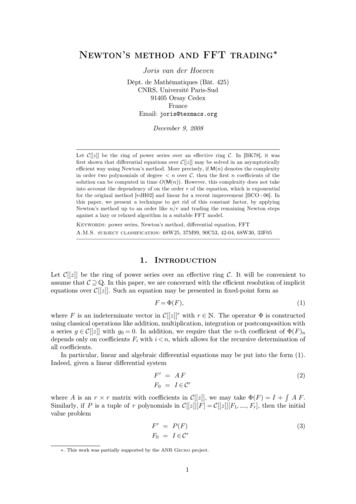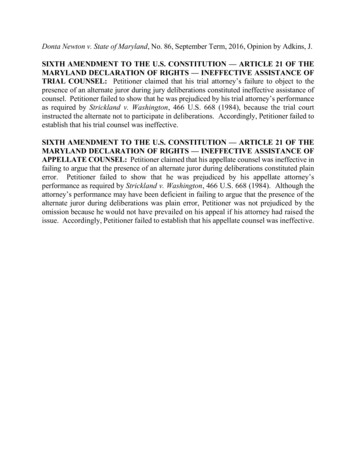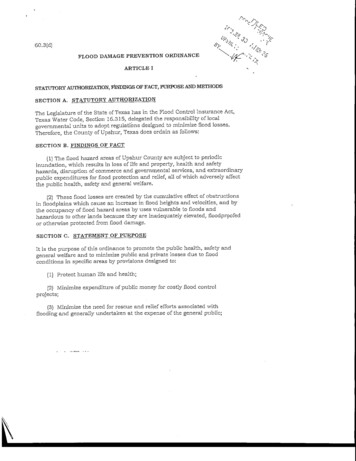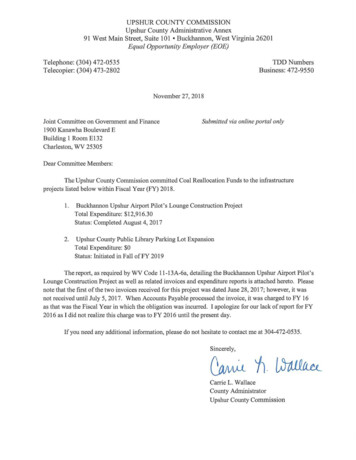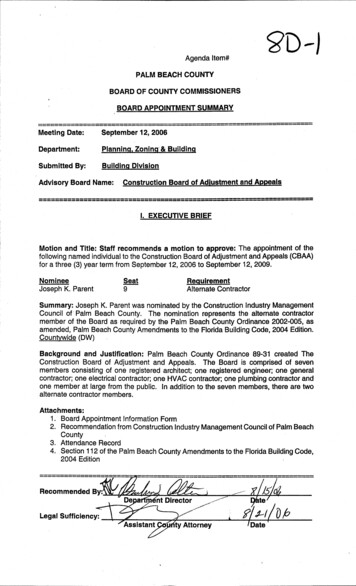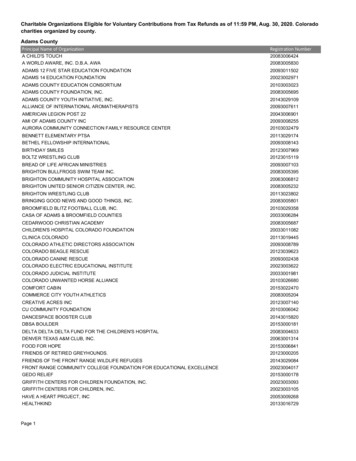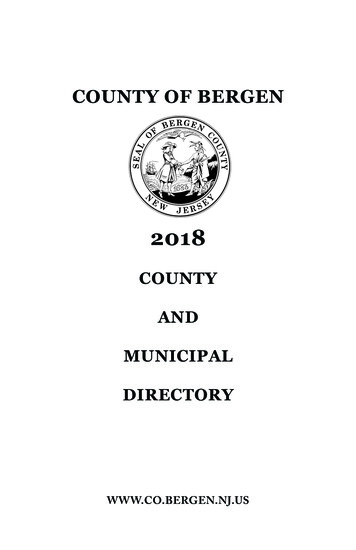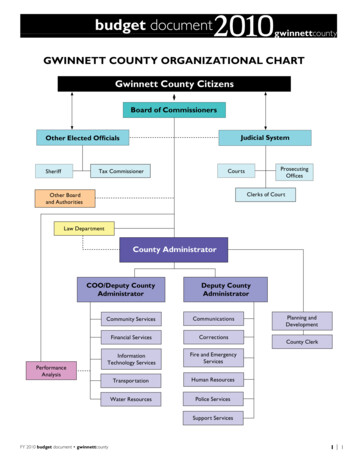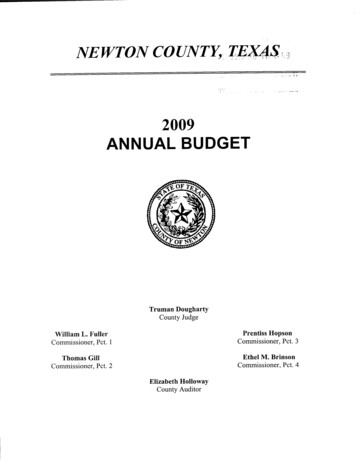
Transcription
NEWTON COUNTY*2009ANNUAL BUDGETTruman DoughartyCounty JudgeWilliam L. FullerCommissioner, Pet. 1Prentiss HopsonCommissioner, Pet. 3Thomas GillCommissioner, Pet. 2Ethel M. BrinsonCommissioner, Pet. 4Elizabeth HollowayCounty Auditor
TABLE OF CONTENTSHistory of Newton CountyLetter of TransmittalBudget CertificateBudget OrderTax Rate OrderBudget CalendarBudget ProcessBudget HighlightsCertification of Appraisal RollCertification of Collection RateCurrent Tax DistributionDelinquent Tax DistributionStatement of IndebtednessFunds and Departments by NumberBudget SummarySummary of Estimated RevenuesSummary of Budgeted ExpendituresBudgeted Full-Time SalariesBudget DetailBudget StatutesCounty Directory
HISTORY OF NEWTON COUNTY, TEXASNewton County is in southeastern Texas on the Louisiana border. Newton, the geographic centerand largest town of the county, is seventy miles northeast of Beaumont. Newton Countycomprises 950 square miles of the lower regions of the East Texas timber belt. Common treesinclude longleaf and short leaf pines, oak, magnolia, hickory and cypress. The rolling terrain,dominated by loamy top soils, ranges from 30 to 300 feet above sea level. The Sabine Riverforms the county's eastern boundary. Major tributaries in the county include, from north to south,Little Cow Creek, Quicksand Creek, Big Cow Creek, and Big Cypress Creek. Oil and gasdominate the county's mineral resources. Temperatures range from an average high in July of93 F to an average January low of 40 F. Rainfall averages just over fifty-four inches annually,the highest for any county in the state. The growing season extends for 228 days per year.Indians were the earliest human inhabitants of Newton County. Artifacts attributed to membersof the Caddo confederacies have been located in present-day Newton County. The Atakapans,whose name means "man-eaters" in Choctaw, occupied the coastal regions around the SabineRiver and may also have ventured into Newton County. The Coushattas, who migrated to lowerEast Texas during the early 1800s, also came through the county. In fact, one of the earliest trailsthrough the area was know as the Coushatta Trace. The lands which eventually comprisedNewton County were included in Lorenzo de Zavala's 1829 grant from the Mexican government.At least twenty-one settlers received title to land now in the county in 1834 and 1835. Most ofthe area of present-day Newton County was part of the Municipality of Liberty from 1831 to1834 and the Municipality of Bevil, which later became Jasper County, from 1834 to 1846. Thearea north of the Little Cow Creek, which includes one-fifth of the present county, was within theMunicipality of San Augustine in 1834-35 and the Municipality of Sabine from 1835 to 1837,before becoming part of Jasper County in 1837. The state legislature marked off Newton Countyon April 22, 1846, from the eastern half of Jasper County and named it in honor of John Newton,a veteran of the American Revolution. The county's boundaries have remained unchanged sincethat time save for a small cession along the western border to Jasper in 1852.The issue of the location of the courthouse dominated Newton County's early history. Electorsoriginally voted to place the seat at the center of the county, and the first commissioners' courtmeetings convened near Quicksand Creek as a result. However, citizens of Burkevillesuccessfully petitioned the Texas legislature to make their town the county seat in 1848. Votersnarrowly approved the new location the following year. In 1853 a dispute concerning land titles,followed by yet another election, resulted in the move of offices to Newton, a newly establishedcommunity at the geographic center of the county. Burkeville citizens refused to give up thestruggle, and an 1855 plebiscite favored Burkeville by a small majority. County officials refusedto leave Newton, however, convincing the legislature to recognize that city as the proper seat ofgovernment, where it has since remained. By 1860 settlers in Newton County had established amixed agricultural economy based on corn, potatoes, cattle, hogs, sheep, and horses. Cottonproduction had jumped from 152 bales in 1850 to 2,091 bales in 1860. Although there were fewlarge planters, the number of slaves was also growing and in 1860 reached 1,103, 34 percent ofthe county's population. From a very early date Baptist and Methodists dominated the county'sreligious life.Newton County citizens overwhelmingly favored the conservative southern Democrat John C.Breckinridge in the 1860 presidential election. Not surprisingly, they supported secession by aneven greater margin. Although some 400 men from Newton County served during the Civil War,the commissioners' court made strenuous efforts to help the remaining citizens avoid much of the
war's immediate economic destruction. The political and social turmoil that affected much of thestate during Reconstruction had little impact on Newton County. County voters supportedRepublican Edmund J. Davis in his successful bid for the governor's office in 1869 but returnedto their traditional Democratic affiliations in the congressional race of 1871. Electors continuedto favor Democrats for the next century, until American party candidate George Wallace receiveda plurality in the 1968 presidential contest. In 1972 the county voted Republican, but from 1876through 1992, Newton County voters supported Democratic presidential candidates.As had been the case before the Civil War, agriculture remained important from 1880 to 1930.The number of farms in Newton County nearly doubled during the fifty-year period. Corn,cotton, cattle, and hogs served as staples in the county's agricultural economy. Sheep ranchingenjoyed a brief span of popularity, although the number of these animals raised in the countydeclined rapidly after 1900. The population grew steadily during these years, from 4,359 in 1880to 12,395 in 1930. Blacks made up over one-third of the almost entirely rural population ofNewton County. The post-Reconstruction period saw a tremendous expansion of the lumberindustry. The census of 1880 estimated total industrial production, largely stemming from waterpowered sawmills, to be just over 25,000. Early lumbermen used animal teams or creeks to pullor float their cut timber to the Sabine River, where it was then floated downstream to Orange.Capitalizing on the region's huge expanses of virgin forests, large timber interests becameinvolved in Newton County during the late nineteenth and early twentieth centuries. Includedamong these lumber giants were A.J. Peavy, Henry Lutcher, and John Henry Kirby. By 1929industrial production was over 4,000,000 annually, with 1,383 of the county's 1,461 industrialworkers employed by lumber-related concerns. Nearly two-thirds of the total work force wasnow involved in non-agricultural occupations. The growth of the lumber industry from 1880 to1930 also revolutionized transportation. Early settlers depended upon poorly maintained countyroads and sporadic riverboat service along the Sabine. Promoters had gained charters to establishrailroads in the county as early as 1852. Yet the first completed line of lasting importance toNewton County, a section of the Texarkana and Fort Smith to Ruliff, was not realized until 1897.Lumbermen, seeking to link their forest holdings with their mills, oversaw the rapid expansion ofthe rail system during the early twentieth century. Particularly important were the Orange andNorthwestern, the Sabine and Neches Valley, and the Gulf and Northern.The Great Depression and gradual depletion of available stands of timber had a severe impactupon Newton County. As late as 1940, public emergency work programs employed 468 persons(10.7 percent of the total work force); another 302 (6.6 percent of the total work force) were stillseeking work. Mill closings at Deweyville, Call, and Wiergate also hurt the county's economy.Industrial production fell 37 percent from 1930 to 1940. These factors were undoubtedlyimportant in the 21 percent decline in population from 1940 to 1950 and a further 9.6 percentdrop from 1950 to 1960. As a result of the economic woes, increasing numbers of persons beganto seek work outside Newton County. Industrial plants at Beaumont and Orange attractedparticularly large numbers. Fortunately, these commuters were able to use the county'simproving system of roadways. U.S. Highway 190, which provides the main east-westthoroughfare, was paved by the mid-1940s. State Highway 87, the major north-south route, wascompletely paved by 1955. The number of registered motor vehicles nearly double between 1935and 1962, again reflecting the greater mobility of Newton County residents after the World WarII.Other changes also contributed to the transformation of life in Newton County. While a fewtowns (including Newton and Deweyville) had electric service before 1925, electricity becameavailable for the county's rural residents during the late 1930s. As part of the New Deal's RuralElectrification Administration, the Deep East Texas Electric Cooperative provided electric power
to the northern part of the county. The Jasper-Newton Electric Cooperative served the county'ssouthern residents. Moderate deposits of oil were also found in Newton County. In 1938, theSouth Call Oilfield began producing and was followed by several more fields discovered after1945. Newton County's once declining population has undergone changes in numbers, racialcomposition, and educational levels. After a 1960 figure of 10,372, in 1980 13,227 persons livedin Newton County, a 27.5 percent increase but still less than the high of 13,700 in 1940. Most ofthe population in 1980 remained rural; Newton (1,620), Deweyville (850), and Burkeville (515)are the largest towns. The composition of the population has also changed. In 1940 blacks madeup over 40 percent of the county's population; by 1980 the figure had fallen to just over 24percent. In 1940 slightly more than one-tenth of county residents over twenty-five years of agehad four years of high school education. By 1980 over 45 percent had achieved this level, and 4percent had also completed at least four years of college. Newton County continued to growslowly in the 1980s. In 1990 the county population was 13,569. The Toledo Bend Reservoir,along the northern boundary, provided new recreational facilities and attracted tourist to NewtonCounty. Oil and gas deposits also figured in the local economy. Opportunities in wholesale andretail trade, along with service-related fields, increased in the 1970s and 1980s as well. Thedecline in agriculture from 1930 to 1960 seems to have been halted. The number of farms, whichfell from a high of 1,565 in 1940 to a low of 192 in 1959, increased to 323 in 1982. Whilecotton-growing has virtually disappeared in Newton County, farmers have produced increasingamounts of hay, and cattle-raising continues to play an important role in the county's economy.More importantly, proper forest management and reforestation programs have in recent yearsrejuvenated the county's available timber resources, and in 1990 forestry was the mainagricultural activity in the county.BIBLIOGRAPHY: Newton County Historical Commission, Glimpses of Newton County History(Burnet, Texas: Nortex, 1982). Josephine Cochrum Peavy, A History of Newton County (M.A.thesis, University of Texas, 1942).
COMMISSIONERS COURTTruman Dougharty, County Judgeftlliam L. Fuller, Comm. Pet 1"Thomas T. Gill, Comm. Pet 2Prentiss L. Hopson, Comm. Pet 3Charles A Brinson, Comm. Pet 4Mary Cobb, County ClerkJoe Walker, County SheriffMisti Spacek,CriminalDistrictAttorneyBree Allen, District ClerkKaren Pousson, County TreasurerMelissa J.Burks, Tax Assessor-CollectorElizabeth A. Hollo way, County AuditorSeptember 25, 2008Honorable Commissioners' Court:Truman Dougharty, County JudgeWilliam Fuller, Commissioner, Precinct No. 1Thomas Gill, Commissioner, Precinct No. 2Prentiss Hopson, Commissioner, Precinct No. 3Ethel Brinson, Commissioner, Precinct No. 4In compliance with Section 111.033, Local Government Code of the State of Texas,budget recommendations for the year ending December 31, 2009 are submitted for yourconsideration and approval.This budget is prepared on the basis of 640,188,259 of net taxable value afterexemptions, which is an increase of 11% over the previous year's net taxable value. TheCounty's tax rate is .610957 per 100 of assessed value. Net tax collections areestimated at 100% of the total levy.The County's .610957 tax rate is allocated as follows:General FundRoad & BridgeCommissioners' SpecialDedicated Road.449791.079375.071567.010224The 2009 Budget provides for planned expenditures, net of contingency appropriations,for all operating funds totaling 23,920,391.58. Contingencies in the amount of 250,000.00 in the General Fund have also been appropriated. Such contingentappropriations are under the control of the Commissioners' Court and shall be distributedby that Court.Newton County Courthouse110 Court St. P. O. Drawer J, Newton, TX 75966 Office: (409) 379-5691 Fax: (409) 379-2107truman.dougharty@co.newton.tx.us
Annual budgets are adopted for all funds except for certain special revenue funds wherefunds are designated for specific purposes as identified in the grant award documents,which adopts grant year or project length financial plans.It is my opinion that the provisions of revenues and expenditures in this budget areadequate and that funds will be on hand to pay the obligations as set forth. All funds areexpected to have sufficient resources to operate within the budgets as proposed. It isintended that each County department will operate within its total budget allocation.Sincerely,Elizabeth HollowayCounty Auditor
BUDGETCERTIFICATEBudget of Newton County, TexasBudget year January 1, 2009 through December 31, 2009THE STA IE OF TEXASCOUNTY OF NEWTONWe, Truman R. Dougharty, County Judge and Elizabeth A. Hollowa
The Jasper-Newton Electric Cooperative served the county's southern residents. Moderate deposits of oil were also found in Newton County. In 1938, the South Call Oilfield began producing and was followed by several more fields discovered after 1945. Newton County's once declining population has undergone changes in numbers, racial composition, and educational levels. After a 1960 figure of .

